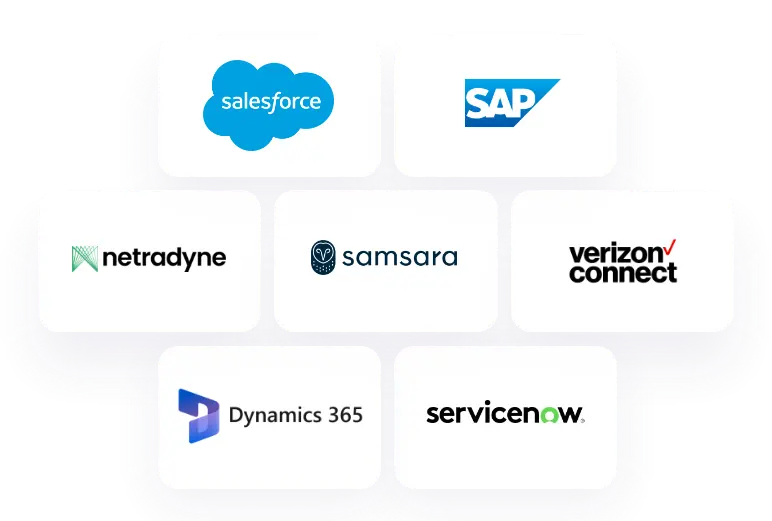Table of Contents
Still manually planning routes and missing out on efficiency gains? Leveraging the data from your existing telematics platform can be a game-changer. By integrating it with a powerful Route Optimization API, you can unlock a world of automated route planning, optimized for real-world conditions. This eliminates the disconnect between planned routes and reality, leading to significant efficiency improvements for your fleet.
Imagine having real-time visibility into how your meticulously planned routes translate to the real world. This dynamic duo allows you to leverage the data collected by your telematics system — vehicle location, driver behavior, stop times — and integrate it with advanced route optimization algorithms. This creates a single, unified view of your entire delivery operation, allowing you to drive up operational performance, enhance customer experience and increase the accuracy of future route plans.
What Is a Route Optimization API? And What Are Its Benefits?

A Route Optimization API is a tool that uses advanced algorithms to determine the most efficient routes for a fleet of vehicles. It considers various factors such as traffic conditions, delivery windows, vehicle capacities and road restrictions to create optimal routes. This technology ensures that vehicles spend less time on the road, reducing fuel consumption and operational costs while improving delivery times and customer satisfaction.
There are several advantages to using a Route Optimization API compared to traditional route planning methods:
- Flexibility: APIs are designed for easy integration with various software systems. This allows you to leverage your existing tech stacks without needing to completely overhaul your IT infrastructure.
- Faster go-live: Unlike complex software installations, Route Optimization APIs can be implemented quickly and with minimal disruption to your operations. This means you can start reaping the benefits of optimized routes sooner.
- Scalability: As your business grows, your delivery needs will evolve. An API approach allows you to easily scale your route optimization solution to accommodate additional constraints, parameters, unique business logic, routes, vehicles and drivers.
- Real-time optimization: Unlike static route plans, APIs can access and process real-time traffic data. This allows for dynamic route adjustments based on unforeseen delays or changing conditions, ensuring your deliveries remain efficient.
- Reduced operational costs: Optimized routes lead to less travel time, reduced fuel consumption and fewer wasted resources. Route Optimization APIs can significantly impact your bottom line by streamlining your delivery operations.
By integrating a Route Optimization API with your telematics platform, you gain a powerful tool to improve efficiency, save costs and enhance customer satisfaction through faster deliveries.
Advanced route planners like NextBillion.ai offer seamless integration with leading telematics providers, enterprise cloud solutions, ERPs and CRM platforms such as Samsara, Salesforce, Netradyne, SAP, ServiceNow, Dynamics 365 and Verizon Connect.
In this blog post, we’ll explore eight compelling benefits of integrating a route optimization API with telematics platforms.
8 Advantages of Integrating Route Optimization APIs with Telematics

1. Enhanced Fleet Efficiency
Integrating route optimization APIs with ERP and CRM platforms significantly boosts fleet efficiency. By leveraging real-time data from telematics, route optimization algorithms can dynamically adjust routes based on current traffic conditions, vehicle locations and delivery schedules. This ensures that each vehicle takes the most efficient path, reducing travel time and fuel consumption.
Advanced route planners like NextBillion.ai can optimize complex routes with multiple stops and multiple vehicles, considering various constraints such as delivery sequence, task priority, vehicle capacity, delivery windows and road restrictions.
2. Reduced Operational Costs
Operational costs are a major concern for fleet managers. Fuel expenses, transportation costs, vehicle maintenance and labor costs can quickly add up. Route optimization APIs help reduce these costs by minimizing unnecessary mileage and optimizing vehicle utilization.
NextBillion.ai’s Route Optimization API also includes vehicle cost attributes (fixed, per hour and kilometer cost) that help to set a base cost for using a vehicle. These attributes allow fleet managers to accurately define and control the cost of using each vehicle
3. Better ETAs, Better Customer Experience
In today’s competitive market, customer satisfaction is paramount. Integrating route optimization APIs with telematics platforms enables businesses to provide more accurate and reliable arrival times. Real-time tracking and optimized routes ensure timely deliveries, reducing delays and enhancing customer trust.
Moreover, customers can receive real-time updates on their shipments, improving transparency and communication.
NextBillion.ai’s AI-powered optimization engine consistently generates accurate ETAs. It ensures precision for real-time dispatch, departure-time-based routes, vehicle-specific arrivals and re-optimized times for new tasks.
4. Smarter Resource Allocation
Route optimization goes beyond saving time and fuel. Advanced route optimization APIs ensure the right person is assigned to the right job. For instance, NextBillion.ai Route Optimization API’s ‘skills’ parameter considers driver qualifications (like an inter-state driver’s license or transportation certificate) when planning routes.
This eliminates wasted time assigning unsuited personnel and maximizes asset utilization – ensuring vehicles aren’t idle and are constantly assigned tasks within their capabilities. Businesses can also monitor vehicle and driver performance, identify inefficiencies and make data-driven decisions.
5. Scalability and Flexibility
As businesses grow, their operational needs evolve. Integrating route optimization APIs with telematics platforms provides the scalability and flexibility required to adapt to changing demands. Whether managing a small or large fleet, route optimization solutions like NextBillion.ai can scale accordingly.
NextBillion.ai supports over 50+ constraints to help optimize large-scale operations. This is essential for businesses managing extensive fleets with multiple vehicle types and complex logistics requirements. These constraints streamline logistics from the first mile to the last mile, enabling efficient multi-route and multi-vehicle planning with thousands of waypoints.
This flexibility ensures that businesses can continue to optimize their operations as they expand, maintaining efficiency and cost-effectiveness. It also allows for a unified and streamlined approach to fleet management.
6. Truck-Compliant Routing
Integrating advanced route optimization APIs like NextBillion.ai with telematics platforms ensures vehicle-specific routes, including trucks, that comply with various regulations. You can account for truck dimensions like width and height, helping trucks avoid low bridges and narrow roads.
With NextBillion.ai, fleet managers can also tailor safe routes for hazmat trucks by specifying the type of hazardous material being carried. This ensures hazmat trucks steer clear of restricted areas and stay compliant with hazardous material regulations. The API also minimizes costs by adjusting routes to include or avoid tolls, ferries, tunnels and highways based on preferences and operational needs.
Advanced route optimization APIs like NextBillion.ai prevent compliance problems caused by generic four-wheeler routes. They create routes that are both legal and cost-effective, leading to smoother operations.
7. Dynamic Route Planning
Utilizing historical and real-time data helps you anticipate potential challenges and plan for contingencies. If your drivers consistently experience heavy traffic during certain times, the route planner can help you schedule deliveries when traffic is lighter, improving efficiency.
NextBillion.ai’s Route Optimization API accounts for historical traffic patterns and combines them with real-time traffic data while planning routes. This allows for proactive adjustments to schedules or routes, minimizing delays and maintaining on-time arrival or service completion. In the event of accidents or road closures, the system can dynamically reroute mobile workers or vehicles to avoid disruptions, minimizing inconvenience for customers or clients.
8. Data-Driven Insights
Telematics systems generate vast data on vehicle performance, driver behavior and route efficiency. Integrating this data with route optimization allows companies to make informed decisions based on real-time insights.
Companies can analyze data on fuel consumption, idle times and vehicle utilization to pinpoint inefficiencies and areas for improvement. Additionally, this data-driven approach supports predictive maintenance by identifying potential vehicle issues before they lead to breakdowns, reducing downtime and maintenance costs. The result is better resource allocation, improved route planning, and enhanced overall efficiency, leading to significant cost savings and optimized fleet performance.
Gain a Competitive Edge by integrating Telematics and Route Optimization API

Integrating route optimization API with telematics could be a game-changer for your business. Telematics provides real-time data on vehicle conditions and location, while the route planner application helps plan the most efficient routes. Together, they create a synergy that maximizes efficiency, minimizes costs and keeps your business on the road to success.
Advanced route planners like NextBillion.ai make it easy to integrate these technologies, providing seamless and efficient fleet management solutions. By leveraging the combined power of telematics and route optimization, businesses can significantly improve their operations, delivering better service to their customers and driving growth.
Learn more about Route Optimization:
- 7 Tips for Route Optimization (2024)
- How to choose the Best Route Optimization API
- Complete Guide to Route Optimization
Frequently Asked Questions (FAQs) about Telematics and Route Planner Integration
What is telematics?
Telematics refers to the use of telecommunications and informatics to send, receive and store information related to remote objects, such as vehicles. It encompasses GPS technology, navigation systems and fleet management software to monitor and manage vehicle performance and behavior.
What is route optimization API?
Route optimization API uses algorithms to determine the most efficient routes for a fleet of vehicles. It considers various factors such as traffic conditions, delivery windows, vehicle capacities, and road restrictions to optimize routes, reducing travel time and operational costs.
How does route optimization API integrate with telematics?
Route optimization API integrates with telematics by using real-time data provided by telematics systems. This integration allows the API to dynamically adjust routes based on current traffic conditions, vehicle locations and other relevant data. The seamless communication between telematics and route optimization API ensures that fleets operate efficiently and effectively.
What is a route planner, and how does it work?
A route planner is a tool that helps determine the best possible route for a vehicle or fleet of vehicles. It takes into account various factors such as traffic conditions, delivery time windows, vehicle capacities, and specific route constraints. By using advanced algorithms and real-time data, a route planner optimizes the travel path to minimize travel time, reduce fuel consumption and improve overall efficiency.
Ready to get started?
Request a DemoTable of Contents





